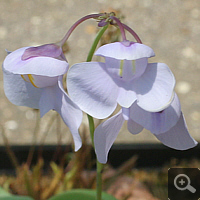Bladderwort (Utricularia)
Overview
The genus Utricularia represents with circa 220 species worldwide the second largest group of carnivorous plants. Anatomy of Utricularias is complex and between the several species furthermore yet divergent. To avoid at this point a detailed excursion into botanical nomenclature, I reduce somewhat the structure of bladderworts, albeit in that case this is anatomically not entirely accurate. Utricularias have no roots, to put it simply they consist of sprouts, traps, leaves and blossoms.
You can simplified divide the giant group of Utricularias into three large subgroups, which are to cultivate entirely divergent:
1. Aquatic Utricularias: This one is the second largest group. Some species are hardy, they survive winter through turions. To this group belong the seven in Germany native species. The most known, non-hardy, aquatic bladderwort is the easy to cultivating Utricularia gibba.
2. Terrestrial Utricularias: This group is by far the largest one. The species are mostly subtropical to tropical and easy to cultivate. Greatest problem is purity of variety, both concerning purchase and also later in culture. If the pots stand too closely side by side, it will establish quickly a bladderwort potpourri.
3. Epiphytic Utricularias One to two dozen species grow epiphytic in South America. Therefore they are ‚air plants‘, which grow for example in moist branch forks or in moss pads. This group is relatively difficult, but very worthwhile. Large, colourful blossoms are produced, which are in no way inferior to orchid blossoms. Well-known members of this group are Utricularia alpina, Utricularia humboldtii or Utricularia longifolia.
Trap mechanism
The trap mechanism was already detailed described on the previous site.
Culture and propagation
Because the culture of the different groups differs considerably, follow now separated culture intructions:
1. Aquatic Utricularias: Hardy species are cultivated best within a raised bog bed. Utricularia australis, Utricularia stygia and Utricularia vulgaris grow rather large and require thus either a large ditch or can also be cultivated in a nutrient-poor garden pond, because they are less fastidious. Utricularia bremii, Utricularia intermedia, Utricularia minor and Utricularia ochroleuca are distinct smaller. In autumn these species produce hardy turions (winter buds), which sink to the floor and overwinter there. The few non-hardy species must be cultivated in an aquarium. A low water level and a fine peat layer as soil are sufficient. Soil/water should be nutrient-poor, so that an algae growth on the plants would not occur. Propagation is very easy, because aquatic species produce during growth numerous sideshoots.
2. Terrestrial Utricularias: Pure white peat as soil is sufficient. Watering occurs as ebb and flow system. The pots can mostly also short-term be flooded. Choose as location a light and warm, but against direct sunlight protected place. A culture on the windowsill is indeed to consider as ideal. They can be cultivated there all-the-year. The creeping sprouts leave quickly the pot and attempt to grow into the next one. Therefore the pots should stand in an adequate distance to each other to avoid an Utricularia-potpourri. Many species flower abundantly. The blossoms are indeed small, but nevertheless attractive, because they occur in almost all imaginable colours. A propagation by division is very easy, but also can theoretically take place by seeds. Terrestrial Utricularias are endangered by aphids and grey mould, which appears in the case of a mismatch between temperature, lighting conditions and humidity.
3. Epiphytic Utricularias The group of epiphytic Utricularias is by far the most attractive, but also the most difficult group. It are produced large, leathery leaves and also colourful, splendid and large blossoms. In compliance with the natural habitat these species wish a loose and airy soil. A mixture of peat, pine bark and peat moss has proved. The soil is to keep evenly moist but never wet. Desired is a light, humid and moderate warm location with a distinct night-time temperature drop. Therefore a long-term culture is only possible under glass. Relatively tolerant concerning their demands are still Utricularia alpina and Utricularia longifolia.

